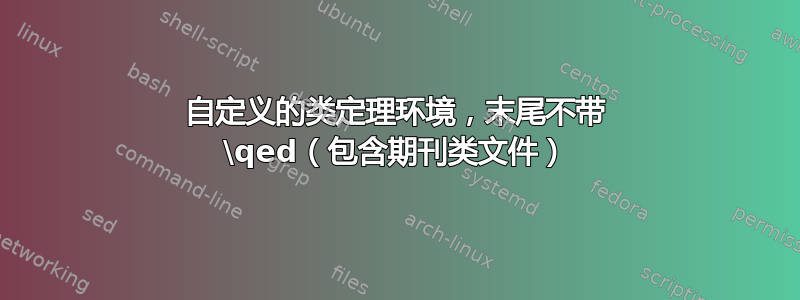
受到法国旧报纸风格的启发,例如 Borel 和 Tits,还原组,我在我的论文中使用了我的自定义类定理环境subsec:
\newtheorem{subsec}[equation]{}
它与以下amsart课程配合得很好:
\documentclass[a4paper,11pt]{amsart}
\numberwithin{equation}{section}
\theoremstyle{plain}
\newtheorem{thm}[equation]{Theorem}
\theoremstyle{definition}
\newtheorem{rem}[equation]{Remark}
\newtheorem{subsec}[equation]{}
\begin{document}
\section{Motivation} \label{s:motivation}
\begin{subsec}\label{ss:mod-Y}
Throughout the article, $k_0$ is a field of characteristic $0$,
and $k$ is a fixed algebraic closure of $k_0$.
\end{subsec}
\begin{rem}
We use the term ``$k_0$-model'' rather than ``$k_0$-form''
because the term ``form'' is overloaded.
\end{rem}
\begin{thm}
For any two numbers $x,y\in{\mathbb R}$, we have
\begin{equation} x+y=y+x.\end{equation}
\end{thm}
\begin{proof} This is well known. \end{proof}
\begin{subsec} A $k_0$-torus $T_0$ is called {\em split}
if it is isomorphic to $({\mathbb G}_{m,k_0})^n$
for some natural number $n$, where ${\mathbb G}_{m,k_0}$
is the multiplicative group over $k_0$.
\end{subsec}
\end{document}
 现在我的论文已经被《国际数学研究通报》(IMRN)接受发表,我必须用期刊类文件来准备它
现在我的论文已经被《国际数学研究通报》(IMRN)接受发表,我必须用期刊类文件来准备它oupau.cls。这个类文件可以从期刊网页上下载(点击Tex模板)。请参阅下面的相应文件,它与上一个文件的唯一本质区别是第一行\documentclass{oupau}而不是 \documentclass[a4paper,11pt]{amsart}:
\numberwithin{equation}{section}
\theoremstyle{definition}
\newtheorem{thm}[equation]{Theorem}
\newtheorem{rem}[equation]{Remark}
\newtheorem{subsec}[equation]{}
\begin{document}
\section{Motivation} \label{s:motivation}
\begin{subsec}\label{ss:mod-Y}
Throughout the article, $k_0$ is a field of characteristic $0$,
and $k$ is a fixed algebraic closure of $k_0$.
\end{subsec}
\begin{rem}
We use the term ``$k_0$-model'' rather than ``$k_0$-form''
because the term ``form'' is overloaded.
\end{rem}
\begin{thm}
For any two numbers $x,y\in{\mathbb R}$, we have
\begin{equation} x+y=y+x.\end{equation}
\end{thm}
\begin{proof} This is well known. \end{proof}
\begin{subsec}
A $k_0$-torus $T_0$ is called {\em split}
if it is isomorphic to $({\mathbb G}_{m,k_0})^n$
for some natural number $n$, where ${\mathbb G}_{m,k_0}$
is the multiplicative group over $k_0$. \end{subsec}
\end{document}```
See the result at the end of my question (I could not put it here...)
As you can see, the ```oupau```` class puts a *solid square* at the end of the proof,
and it puts an *empty square* ```\qed```
at the end of each theorem-like environment.
In particular, each time when I write ```\end{subsec}```
I get a ```\qed``` symbol, which I don't need!
> **Request.** Please write for me a theorem-like environment ```subsec```
that will not put a ```\qed```-symbol when I write ```\end{subsec}```.
See below the relevant part (?) of the ```oupau``` class file.
\DeclareRobustCommand{\qedthm}{%
\ifmmode \mathqed
\else
\leavevmode\unskip\penalty9999 \hbox{}\nobreak\hfill
\quad\hbox{\qedsymbolthm}%
\fi
}
\def\@begintheorem#1#2[#3]{%
\pushQED{\qedthm}\deferred@thm@head{\the\thm@headfont \thm@indent
\@ifempty{#1}{\let\thmname\@gobble}{\let\thmname\@iden}%
\@ifempty{#2}{\let\thmnumber\@gobble}{\let\thmnumber\@iden}%
\@ifempty{#3}{\let\thmnote\@gobble}{\let\thmnote\@iden}%
\thm@swap\swappedhead\thmhead{#1}{#2}{#3}%
\the\thm@headpunct
\thmheadnl % possibly a newline.
\hskip\thm@headsep
}%
\ignorespaces}
\def\@endtheorem{\popQED\endtrivlist\@endpefalse }
%
\theoremstyle{definition}
\newtheorem{theorem}{Theorem}[section]
\newtheorem{lemma}[theorem]{Lemma}
\newtheorem{corollary}[theorem]{Corollary}
\newtheorem{proposition}[theorem]{Proposition}
\newtheorem{definition}[theorem]{Definition}
\newtheorem{example}[theorem]{Example}
\newtheorem{exercise}[theorem]{Exercise}
%
\newcommand{\filledbox}{\leavevmode
\hbox to.77778em{%
\hfil\vbox to.675em{\hrule width.6em height.6em}\hfil}}
\renewcommand{\qedsymbol}{\filledbox}
\renewenvironment{proof}[1][\proofname]{\par\noindent
\pushQED{\qed}%
\normalfont \topsep6\p@\@plus6\p@\relax
\trivlist
\item[\hskip\labelsep
\textbf
#1\@addpunct{.}]\ignorespaces
}{%
\popQED\endtrivlist\@endpefalse
答案1
尝试用以下内容替换subsec使用的定义\newtheorem
\newenvironment{subsec}{%
\noindent\refstepcounter{equation}{\normalfont\bfseries\theequation.}\hspace{0.5em}}{}
可能\hspace需要进行调整,我不知道在定理环境中定理头和主体之间的间距是多少oupau.cls。
答案2
我自己对我的问题的回答(使用这个答案 相关问题,以及此评论)。其思想是\@endtheorem通过删除来重新定义宏\qed。
% redefine the \@endtheorem macro
\makeatletter
\def\@endtheorem{\endtrivlist\@endpefalse } % delete `\qed` macro
\makeatother
%
\newtheoremstyle{subsecthmstyle}{}{}{}{}{\bf}{.}{ }{}
\theoremstyle{subsecthmstyle}
\newtheorem{subsec}[equation]{}



